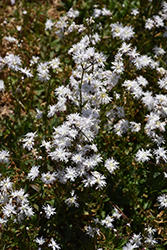It's all about ...
plants

Petit Henri Ragged Robin Campion
Lychnis flos-cuculi 'IFLYPH'
Plant Height: 18 inches
Flower Height: 24 inches
Spacing: 24 inches
Sunlight:
![]()
![]()
Hardiness Zone: 4a
Brand: Ball
Description:
A compact, tufted perennial with oblong, gray-green foliage, presenting double, bright white flowers that float above the foliage on upright, slender burgundy stems; blooms late spring to fall; an extremely showy plant especially when planted in masses
Ornamental Features
Petit Henri Ragged Robin Campion has masses of beautiful white frilly flowers with buttery yellow eyes at the ends of the stems from late spring to early fall, which are most effective when planted in groupings. The flowers are excellent for cutting. Its attractive tomentose pointy leaves remain grayish green in colour throughout the season. The burgundy stems can be quite attractive.
Landscape Attributes
Petit Henri Ragged Robin Campion is an open herbaceous perennial with a mounded form. It brings an extremely fine and delicate texture to the garden composition and should be used to full effect.
This plant will require occasional maintenance and upkeep, and should be cut back in late fall in preparation for winter. It is a good choice for attracting butterflies to your yard, but is not particularly attractive to deer who tend to leave it alone in favor of tastier treats. It has no significant negative characteristics.
Petit Henri Ragged Robin Campion is recommended for the following landscape applications;
- Mass Planting
- Rock/Alpine Gardens
- Border Edging
- General Garden Use
- Naturalizing And Woodland Gardens
- Container Planting
Planting & Growing
Petit Henri Ragged Robin Campion will grow to be about 18 inches tall at maturity extending to 24 inches tall with the flowers, with a spread of 24 inches. When grown in masses or used as a bedding plant, individual plants should be spaced approximately 24 inches apart. It grows at a fast rate, and under ideal conditions can be expected to live for approximately 10 years. As an herbaceous perennial, this plant will usually die back to the crown each winter, and will regrow from the base each spring. Be careful not to disturb the crown in late winter when it may not be readily seen!
This plant does best in full sun to partial shade. It prefers to grow in average to moist conditions, and shouldn't be allowed to dry out. This plant should not require much in the way of fertilizing once established, although it may appreciate a shot of general-purpose fertilizer from time to time early in the growing season. It is not particular as to soil type or pH. It is somewhat tolerant of urban pollution. This is a selected variety of a species not originally from North America.
Petit Henri Ragged Robin Campion is a fine choice for the garden, but it is also a good selection for planting in outdoor pots and containers. It can be used either as 'filler' or as a 'thriller' in the 'spiller-thriller-filler' container combination, depending on the height and form of the other plants used in the container planting. Note that when growing plants in outdoor containers and baskets, they may require more frequent waterings than they would in the yard or garden. Be aware that in our climate, most plants cannot be expected to survive the winter if left in containers outdoors, and this plant is no exception. Contact our experts for more information on how to protect it over the winter months.
This plant is not reliably hardy in our region, and certain restrictions may apply; contact the store for more information.
